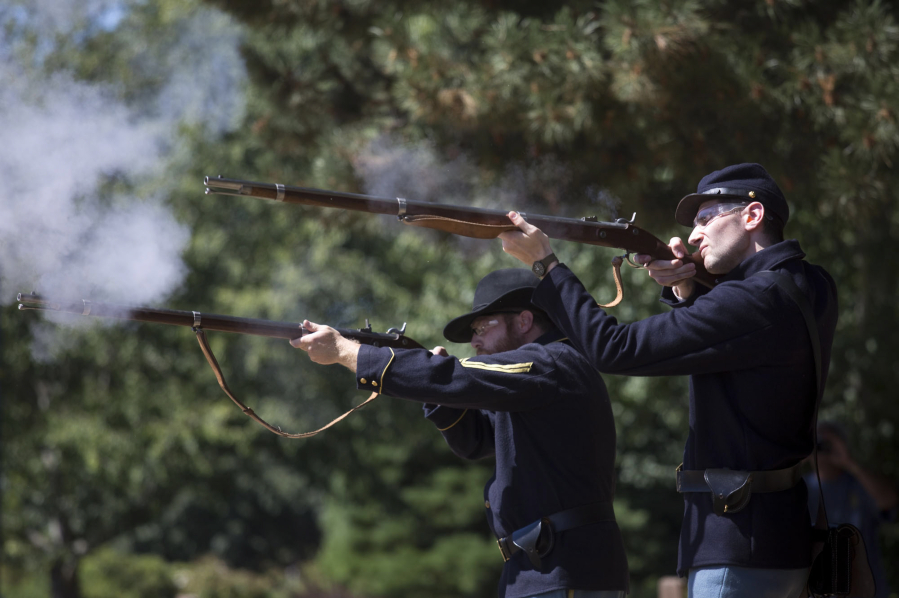When fired, the 1861 Springfield rifle-musket and the 1873 Trapdoor Springfield rifle both make a sharp clap. The 1841 Mountain Howitzer, a cannon, provides a louder, bigger boom. All three weapons — loaded with blanks, of course — were fired off Saturday in a demonstration on the parade ground at Fort Vancouver National Historic Site.
About a dozen people came to watch and learn about these historic weapons of war.
“Did a lot of the soldiers lose their hearing?” someone asked.
“Oh, very much so,” said Bob Cromwell, chief of interpretation at the historic site.
Saturday’s black powder weapon demonstration was the last in a monthly summer series. However, re-enactors will be firing off weapons in front of the reconstructed Fort Vancouver as part of Campfires & Candlelight, the national park’s largest event of the year happening Sept. 9. Cromwell said close to 200 staff and volunteers will be dressed in period clothing re-creating a timeline from the Oregon Trail period to World War II. Inside the reconstructed Fort Vancouver, people will be re-enacting a night in 1844 with everything lit by candlelight. Somewhere between 5,000 to 7,000 visitors are expected depending on the weather.
Nancy McDonald has been to Campfires & Candlelight before, as well as the holiday re-enactments and the baseball games.
“We come because of the history, because of the performance aspect of it. We love the re-enactors,” said McDonald, who is a theatre director and teacher. “They’re so thorough.”
Fog of war
All three weapons demonstrated Saturday put off a lot of white smoke from the black powder. Historically, after a few volleys among thousands of soldiers, battlefields would become enveloped in smoke. Smokeless powder wasn’t developed until some time later.
“It was a constant challenge for those generals to figure out what on earth is going on out there,” Cromwell said. “The fog of war — it was a literal thing during this time period.”
In 1849, the U.S. Army arrived at the Hudson’s Bay Company’s wharf (then located where Joe’s Crab Shack is now). During that time, weapon technology evolved. The Army established a firing range where the Marshall Center is today. The site of the visitor center used to have an arsenal for manufacturing weapons and ammunition and keeping weapons ready for battle.
The 1861 Springfield rifle-musket was the most common weapon of the Civil War with over 1 million manufactured, costing the U.S. government $20 apiece, Cromwell said. If someone was struck in the arm or leg with the ammunition, a minie ball, it would smash bone.
“Even today, surgeons would be challenged to do anything with a wound like that. And, back then, the only solution was to actually amputate the limbs,” Cromwell said.
Soldiers could visually see spent shot coming at them and could side step it if they had enough time, he said.
Leftover 1861 Springfields were later converted from muzzle-loaded weapons to chamber-fired weapons. The 1873 Trapdoor Springfield fired a metallic cartridge like what guns have today, and it could be reloaded faster; trained soldiers could fire off six shots per minute. This was used until it was replaced by the .30-40 Krag.
The 1841 Mountain Howitzer was operated by four men and packed by three mules. At the intersection of Fort Vancouver Way and Evergreen Boulevard is a replica of a Napoleon Howitzer, a heavier cannon.
The Mountain Howitzer charged by black powder was designed to explode over enemies’ heads and rain down shards of metal. The Army had this weapon during the 1877 Battle of White Bird Canyon in Montana when there was a surprise attack on the Nez Perce, who chased the Army across a river. Soldiers with the cannon were behind everyone else and decided to hastily defend themselves by shooting the cannon while it was still on a mule’s back. It stopped the Nez Perce, but that mule ran away, Cromwell said.
People can still buy black powder today. The maximum amount a person can have without a federal firearm license is 50 pounds.
“When you order 15 pounds of black powder, you can expect an agent of the Bureau of Alcohol, Tobacco, Firearms and Explosives to give you a call,” Cromwell quipped.
These weapons will be demonstrated Saturday at Campfires & Candlelight. Next year, Cromwell hopes to get people certified to do saber (sword) demonstrations.




